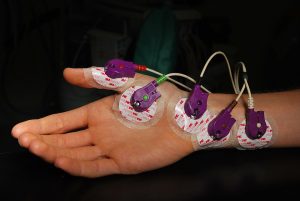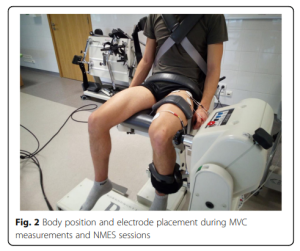Alan Jenks
Recall that nerves carry information throughout the body in the form of electrical signals called action potentials. These signals are what cause our muscles to contract, our heart to beat, our diaphragm to draw air into our lungs; whether we are consciously aware of it or not, essentially everything that happens in the body happens because the nervous (and endocrine) system tells it to!
We have the ability to ‘tap in’ to this internal electrical messaging system through external methods. By administering an external stimulation to the nerve, we can induce an artificial response in the effector, without involving the central nervous system.
When the effector is a skeletal muscle, we can see the result of this stimulation as a muscle twitch. If the electrical stimulation is low, only a few motor units with be recruited and we will see a small twitch in the muscle.
As the amplitude of the stimulation increases, more and more motor units are recruited and the resultant twitch will get larger until a maximum is reached, however the maximum induced by the twitch is well below that which can be achieved through voluntary contraction.

Scientists primary use muscle twitch to assess Voluntary Activation (VA).
This is a way for researchers to know if a human muscle is fully activated (ie-maximal recruitment has occurred) during an attempted maximal voluntary effort (Hales & Gandevia, 1988).
Why is this important? Well let’s say you wanted to examine the effect of a fatiguing contraction on the gastrocnemii.
You would collect a baseline Maximal Voluntary Contraction (MVC) by having the subject perform plantar flexion against a force plate and record the result.
Then you would ask them to do submaximal fatiguing plantar flexion contractions, then repeat the MVC. We would hypothesize that the MVC would decrease after the subject was fatigued, but what if the subject wasn’t fatigued and the second time around they just didn’t try as hard during the MVC? We would still see a decrease in the data, but it wouldn’t be due to the intervention!

To prevent this, the researchers will use the twitch interpolation technique to assess voluntary activation.
Essentially a stimulation is applied to a nerve while the muscle it stimulates is trying to produce an MVC effort and if the force increases with the twitch, the muscle is not fully activated (ie-the person is not producing a maximal recruitment effort).
If there is minimal force increase (less than 2%, Hales & Gandevia, 1988) then the muscle is considered fully activated and we can rest assured the person is trying as hard as they can to produce their MVC.
If Twitch is used in conjunction with EMG then researchers can also use it to measure:
- Hoffmann’s reflexes – more commonly called H-reflexes, this is an electrically induced reflex similar to the mechanically induced spinal stretch reflex, with the exception that it bypasses the muscle spindle and therefore gives a better indication of the excitability of the alpha motor neuron, and activity of the mono-synaptic reflex in the spinal cord. This measurement can be used to assess the response of the nervous system to various neurological conditions, musculoskeletal injuries, efficacy of therapy, pain, exercise training and performance (Palmieri, Ingersoll and Hoffman, 2004).
- M-wave – This is the response at the muscle to the simulation of the nerve (efferent pathway). It is not considered a reflex because the action potential elicited from the stimulation does not pass through the spinal cord.
- F-wave – This is used primarily to detect demyelinating neuropathies
When a muscle twitch is applied, information is collected through two mechanisms: EMG tracings and force tracings. EMG will tell us about recruitment, and force tracings will tell us everything else! Sometime visual inspection can tell you if the muscle is fully activated during contraction, but this will likely not hold up under scientific scrutiny!
Media Attributions
- 1200px-Electromyographic_recording_at_adductor_pollicis_muscle_and_stimulation_of_the_ulnar_nerve

